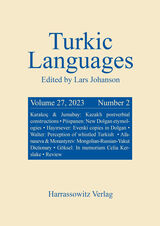Autor: Lars Johanson
- «
- 1
- »
Die Suche erzielte 8 Treffer.
Review of Gültekin, Mevlüt and Yoldaş, Asıf 2002. Afganistan Özbekçesi- Türkçe sözlük [Afghan-Uzbek-Turkish Dictionary]. Ankara: Nobel. frontmatter
In memoriam Ingeborg Hauenschild (1936–2021) obituary
In Memoriam D. M. Nasilov (1935–2017) frontmatter
Five dimensions of linguistic distance article
Degrees of grammaticalization of Kazakh nominal relators article
Editorial note article
Editorial note article
- «
- 1
- »
